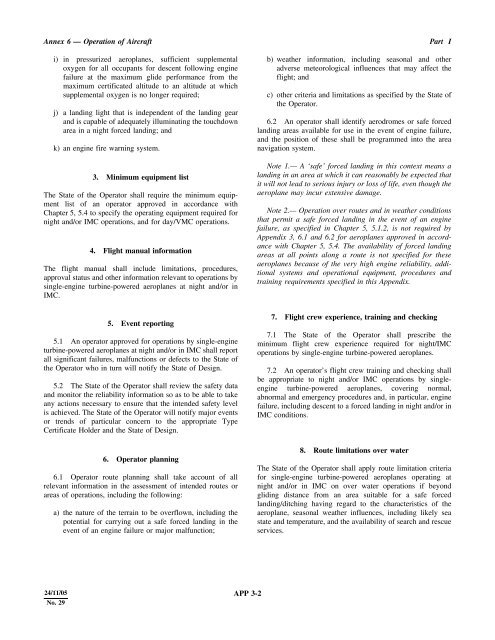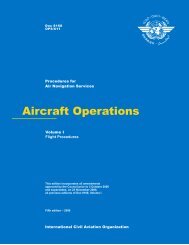Operation of Aircraft
Annex 6, Part I
Annex 6, Part I
- No tags were found...
You also want an ePaper? Increase the reach of your titles
YUMPU automatically turns print PDFs into web optimized ePapers that Google loves.
Annex 6 — <strong>Operation</strong> <strong>of</strong> <strong>Aircraft</strong><br />
i) in pressurized aeroplanes, sufficient supplemental<br />
oxygen for all occupants for descent following engine<br />
failure at the maximum glide performance from the<br />
maximum certificated altitude to an altitude at which<br />
supplemental oxygen is no longer required;<br />
j) a landing light that is independent <strong>of</strong> the landing gear<br />
and is capable <strong>of</strong> adequately illuminating the touchdown<br />
area in a night forced landing; and<br />
k) an engine fire warning system.<br />
3. Minimum equipment list<br />
The State <strong>of</strong> the Operator shall require the minimum equipment<br />
list <strong>of</strong> an operator approved in accordance with<br />
Chapter 5, 5.4 to specify the operating equipment required for<br />
night and/or IMC operations, and for day/VMC operations.<br />
4. Flight manual information<br />
The flight manual shall include limitations, procedures,<br />
approval status and other information relevant to operations by<br />
single-engine turbine-powered aeroplanes at night and/or in<br />
IMC.<br />
5. Event reporting<br />
5.1 An operator approved for operations by single-engine<br />
turbine-powered aeroplanes at night and/or in IMC shall report<br />
all significant failures, malfunctions or defects to the State <strong>of</strong><br />
the Operator who in turn will notify the State <strong>of</strong> Design.<br />
5.2 The State <strong>of</strong> the Operator shall review the safety data<br />
and monitor the reliability information so as to be able to take<br />
any actions necessary to ensure that the intended safety level<br />
is achieved. The State <strong>of</strong> the Operator will notify major events<br />
or trends <strong>of</strong> particular concern to the appropriate Type<br />
Certificate Holder and the State <strong>of</strong> Design.<br />
6. Operator planning<br />
6.1 Operator route planning shall take account <strong>of</strong> all<br />
relevant information in the assessment <strong>of</strong> intended routes or<br />
areas <strong>of</strong> operations, including the following:<br />
a) the nature <strong>of</strong> the terrain to be overflown, including the<br />
potential for carrying out a safe forced landing in the<br />
event <strong>of</strong> an engine failure or major malfunction;<br />
Part I<br />
b) weather information, including seasonal and other<br />
adverse meteorological influences that may affect the<br />
flight; and<br />
c) other criteria and limitations as specified by the State <strong>of</strong><br />
the Operator.<br />
6.2 An operator shall identify aerodromes or safe forced<br />
landing areas available for use in the event <strong>of</strong> engine failure,<br />
and the position <strong>of</strong> these shall be programmed into the area<br />
navigation system.<br />
Note 1.— A ‘safe’ forced landing in this context means a<br />
landing in an area at which it can reasonably be expected that<br />
it will not lead to serious injury or loss <strong>of</strong> life, even though the<br />
aeroplane may incur extensive damage.<br />
Note 2.— <strong>Operation</strong> over routes and in weather conditions<br />
that permit a safe forced landing in the event <strong>of</strong> an engine<br />
failure, as specified in Chapter 5, 5.1.2, is not required by<br />
Appendix 3, 6.1 and 6.2 for aeroplanes approved in accordance<br />
with Chapter 5, 5.4. The availability <strong>of</strong> forced landing<br />
areas at all points along a route is not specified for these<br />
aeroplanes because <strong>of</strong> the very high engine reliability, additional<br />
systems and operational equipment, procedures and<br />
training requirements specified in this Appendix.<br />
7. Flight crew experience, training and checking<br />
7.1 The State <strong>of</strong> the Operator shall prescribe the<br />
minimum flight crew experience required for night/IMC<br />
operations by single-engine turbine-powered aeroplanes.<br />
7.2 An operator’s flight crew training and checking shall<br />
be appropriate to night and/or IMC operations by singleengine<br />
turbine-powered aeroplanes, covering normal,<br />
abnormal and emergency procedures and, in particular, engine<br />
failure, including descent to a forced landing in night and/or in<br />
IMC conditions.<br />
8. Route limitations over water<br />
The State <strong>of</strong> the Operator shall apply route limitation criteria<br />
for single-engine turbine-powered aeroplanes operating at<br />
night and/or in IMC on over water operations if beyond<br />
gliding distance from an area suitable for a safe forced<br />
landing/ditching having regard to the characteristics <strong>of</strong> the<br />
aeroplane, seasonal weather influences, including likely sea<br />
state and temperature, and the availability <strong>of</strong> search and rescue<br />
services.<br />
1/11/01 24/11/05<br />
APP 3-2<br />
No. 29












